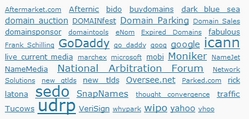IBM files patent application for overcoming limitations of tagging.

IBM wants to improve upon tagging, bringing the idea of the semantic web to tag clouds. And it just filed a patent application for the idea.
U.S. patent application 12/184,731 (pdf) describes what’s wrong with traditional tag clouds, and how IBM wants to apply ontology and relationships to make them more useful. According to IBM, here are the limitations of tagging:
“Although tagging can help users find content, there are some disadvantages associated with tagging. For example, tags are generally single words, as most tagging technologies do not allow multiple word (phrase) tags. Also, users cannot associate a context or description with the tags. For example, a user may tag a picture as “dogâ€. Alone, this tag (dog) could have a variety of meanings (e.g., animal, food, person, etc). Adding context to the tag (e.g., John’s dog plays in the garden) could give users a better understanding of what to expect when they click on the tag. Additionally, different users can use the same tag with different meanings, thus making tags semantically imprecise. For example, a user interested in computers may search for content tagged “Apple†only to receive results related to the fruit. Current tagging technology also does not allow tags to be associated with their synonyms. For example, pictures tagged as “dog†will not show up when a user searches for content associated with the tag “puppyâ€. Therefore, as the tag space grows, the value of tags may diminish.”
But IBM has the solution, it says: a way to apply the semantic web to tag clouds by creating an ontology. Here are some of the benefits:
“Once this ontology (classification) is generated, it can provide users with a better way to visualize the tag environment and describe how individual tags are related to one another. The ontology can also enable users to add description to their tags, thus making tags more understandable, informative (semantically rich), and easy to locate. Additionally, it also results in more precise and specific searches and captures the users’ behavior, usage of words, etc. For example, consider two tags—one that reads “sunset at Pompano beachâ€, the other that reads “sunset at Miami beachâ€. A user may search for content with tags “sunset in Floridaâ€. Using the ontology and the semantic web, the machine may identify that Pompano Beach and Miami Beach are both in Florida and hence display both results. However, the process of generating such a classification is very time consuming, requires people with a lot of programming expertise, and a variety of domain experts. Moreover, users tend to use colloquialisms and people’s vocabulary changes over time.”
The patent application includes a number of methods that can overcome the challenges of relating information in tags.






Clearly, we don’t need patents.
wow what next footer links too to patent ?
There are no limitations to how tags are phrased in our “cloud” on Lawyers Engine™. Check it out:
http://www.lawyersengine.com
Semantic tagging, as described by IBM, exists for several years now and is already implemented in a number of services. Pioneers were Faviki, Zigtag and Zemanta, to name a few. Last year, the joint effort by AdaptiveBlue, DERI, Faviki, Freebase, Yahoo!, Zemanta and Zigtag even managed to produce a standard called the Common Tag (http://commontag.org).
The fact that IBM, who had no role in these efforts so far, is trying to patent this idea makes me sick.
Rod,
How would someone use commontag.org? The concept seems nice but their site doesn’t seem to be updated recently. Is the project making any progress?